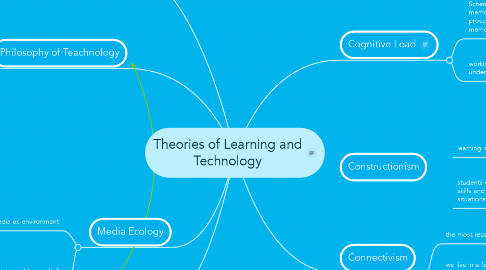
1. Cognitive Load
1.1. Schemas (memory structures stored in a brain's long-term memory) are formed when working memory is processed by the brain and saved in long-term memory
1.1.1. Working memory has a limited capacity, and for real learning to take place, it must be operating at maximum levels
1.1.1.1. long term memory does not
1.2. working memory may be over (or under) loaded
1.2.1. Pedagogical Implications: Remember how our brains successfully create schema. (for example, we can remember seven digits at a time, plus or minus two). Teachers can repeat information often, present new information in smaller, more manageable "chunks," and keep non-necessary material to a minimum.
2. Constructionism
2.1. learning is constructed!
2.1.1. the mind is not a blank slate. New information builds upon pre-existing structures in the brain
2.1.1.1. teachers can apply these principles by designing authentic projects that the students can tackle with the help of their instructor, peers, and a range of other resources
2.2. students can use reflection to build skills and apply knowledge to novel situations
2.2.1. encourages strong social skills and a sense of ownership over personal learning
3. Connectivism
3.1. the most recent theory on learning
3.1.1. learning is not merely an internal activity, Knowing how to learn is equally important.
3.2. we live in a fast-paced world where yesterday's knowledge may become obsolete. Students need to be able to consider new resources carefully to determine whether or not they are relevant to a project
3.2.1. Connectivist teachers have a different role; they act more as a facilitator than a conveyer-of-knowledge
4. Media Ecology
4.1. studies the media as environment
4.1.1. media ecology is, by nature, quite broad
4.1.1.1. response to unprecedented advances in technology
4.1.1.2. can be viewed as a fusing of natural sciences with arts and social sciences. Today's world has no clear distinctions about where one discipline ends and another begins.
4.2. how are we shaped by media?
5. SCOT
5.1. argues that rather than being infgluenced by media, technology is shaped by us
5.1.1. is interested in how and why new technologies develop
6. Philosophy of Teachnology
6.1. Every teacher will develop a philosophy of using technology in the classroom, and it will evolve over time
6.1.1. The use of technology is a given in today's learning environment. To neglect it is to deprive students of skills and knowledge that will benefit them in the real world.
6.1.2. explores questions regarding the type of tools used, the proportion of material covered using various technical tools, the basis of assessment and foals for student learning. Will technical tools be more useful to students in one particular context than another?
7. TPACK
7.1. describes the complex interplay between three fundamental types of knowledge: Content, Pedagogical and Technological
7.1.1. teachers seek the right balance to find the most effective means to use technology and pedagogical knowledge to convey content knowledge to students
7.1.2. As a conceptual framework it has built on the work of Lee Shulman
7.1.3. “Reproduced by permission of the publisher, © 2012 by tpack.org
